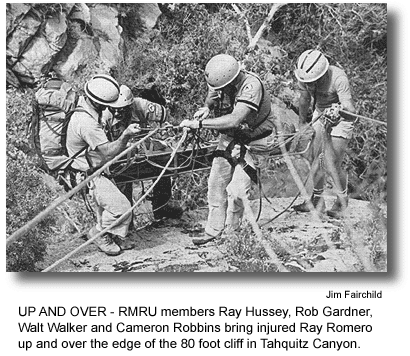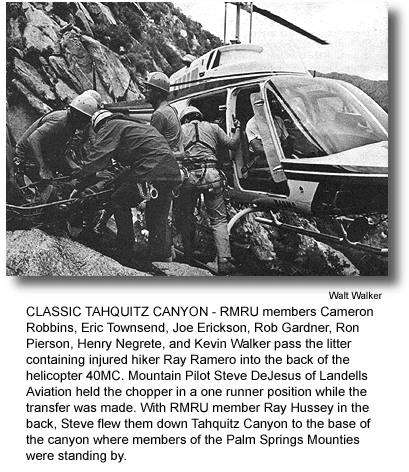Missing hiker went down Tahquitz Canyon
|
May 11, 1987 |
 |
By George Crampon
It was a warm clear morning. The Riverside
Sheriff's Office called RMRU out to search for a
missing adult male hiker, Raymond (Ray) Ramero
had become separated from his three companions
the previous day. When Ray did not return to the
campsite, near Laws Camp, by morning, the
companions summoned help.
A base camp for the RMRU operations was set-up at
Camp Maranatha in Idyllwild. Landells Aviation
provided helicopter service. Kevin Walker, Rob
Garner, and pilot Steve DeJesus Departed for an
aerial assessment and the PLS (point last seen)
and vicinity, it was decided to fly down Tahquitz
Canyon a short distance. In the past, lost people
in the vicinity inadvertently hiked down
difficult Tahquitz Canyon. Tahquitz Canyon is
generally overgrown, without trails, and has many
waterfalls.
As Steve was in a left turn to head back to base
camp to pick-up and disperse ground teams, Kevin
spotted a man at the canyon bottom, sitting on a
large boulder. The man was not moving. His
clothing matched the description of our subject,
Ray Ramero. The canyon had been closed off to the
public for over a decade and nobody else had been
seen in the canyon this day. Therefore it
appeared to be a good chance that this was the
man RMRU was searching for.
Steve circled and let him know that he had been
seen, and then look for a helispot. No helispot
was to be found and eventually Steve touched six
inches of the right helicopter runner on a
pyramid shaped boulder. Rob exited the ship to
learn that there was not any place to stand and
proceeded in an immediate down climb of about ten
feet, finally getting his feet onto loose rock of
the steep, north side of the canyon. The
helicopter had already left and Steve flew down
the canyon to our old helispot where Kevin could
get out of the front seat and move to the right
rear seat. The helicopter then returned to the
pyramid like boulder and the exit process was
repeated by Kevin.
From this point Rob and Kevin hiked for fifteen
minutes before they could see Ray. However, from
that point they needed to get to the bottom of a
sixty foot waterfall and then fifty feet down
canyon to reach Ray. They called to him but ray
continued to sit on a large boulder, facing down
canyon. Ray did not move or try to turn around.
He called-out but could not be understood as he
faced away from Rob and Kevin. With continued
calling and shouting it could finally be
discerned that Ray was saying, "Are you
coming down? Hurry!"
It took another ten minutes to prepare to climb
down. There was not any easy routes on the slick
waterfall wall, but at least the water was at a
slow flow. Rob pulled-out a call-out rope and put
on his sit-harness. Kevin looked for a safe
anchor, without success. Finally, it was decided
Rob would climb down with Kevin belaying, as he
set in a depression of the rock and used his body
for an anchor.
 Keeping the
rope taut Rob climbed down about fifteen feet
above the pool of water and then begin to
traverse. He unropped for the last two moves and
once again his feet were on Grade 3 terrain. He
hiked over to Ray who first said, "I'm sure
glad to see you guys!"
Keeping the
rope taut Rob climbed down about fifteen feet
above the pool of water and then begin to
traverse. He unropped for the last two moves and
once again his feet were on Grade 3 terrain. He
hiked over to Ray who first said, "I'm sure
glad to see you guys!"
It became apparent that Ray was too stiff and
sore to move and that therefore had been unable
to wave to the helicopter or turn around earlier
to call up canyon to Rob and Kevin. Ray was
alert, but he had lumps all over his head,
abrasions on his back and shoulders, and
generally ached. Rob measured Ray's vital signs
and did a head to toe assessment reporting
findings by radio.
Ray Ramero reported that when he was climbing
down the waterfall wall he slipped and fell,
tumbling head over heels several times. He said
he hit his head on the rock as he tumbled. He
landed in the pool of water at the bottom. He
then swam to the side and crawled a few feet to
the boulder he was sitting on. He was unable to
start a fire to keep warm, he did not have any
gear, and was too stiff and sore to reach the
water that ran past him a few feet away.
Kevin radioed-out for the rest of the team to
prepare to fly to the rescue site with ropes,
hardware, etc. if necessary for a technical
rescue using a mechanical advantage (M.A.)
system. They also were to bring in a stokes
litter an immobilization apparatus for neck/back
injury. Kevin had already found a site he could
make into a helispot and was working hard to
clear enough area for the small Jet Ranger
helicopter to touch two skids down.
The helispot ready, RMRU men and gear were flown
to the site. Dr. Ray Hussey was on the first
load, and as soon as anchors were set, he
rappelled down to Rob and Ray Ramero. Dr. Hussey
did another medical evaluation, started to
hydrate Ray and called for the Oregon spine
splint (which had been recently been donated to
RMRU by doctors Mellor, Hussey, and Blaschko).
 While Rob
and Dr. Hussey packaged Ray, into the stoke
litter, and set the litter rigging, the other
team members were flown to the site and set-up
the M.A. system in preparation for the raise. The
raise was to be about seventy feet, to the new
helispot. Ray would be flown out of the canyon
and then transported to the hospital.
While Rob
and Dr. Hussey packaged Ray, into the stoke
litter, and set the litter rigging, the other
team members were flown to the site and set-up
the M.A. system in preparation for the raise. The
raise was to be about seventy feet, to the new
helispot. Ray would be flown out of the canyon
and then transported to the hospital.
There was so little space where Dr. Hussey and
Rob worked that no others could come down to
help, in fact, the foot of the stokes litter had
to hang over the waterfall below them.
The raise was done with some difficulty, but as
soon as Ray was at the top of the raise the
helicopter was called back by radio and made
perfect timing to Fly Ray out of the canyon. A
few hours had gone by from mission start to
getting Ray out of the mountain. In this
instance, use of the helicopter mad a great
savings of time. Without the helicopter Ray would
not have been off the mountain for at least
twenty-four hours.
RMRU cleaned up the gear and was flown back to
base camp, where they had dinner together and
then rode off in different directions each RMRU
member returning to his family.